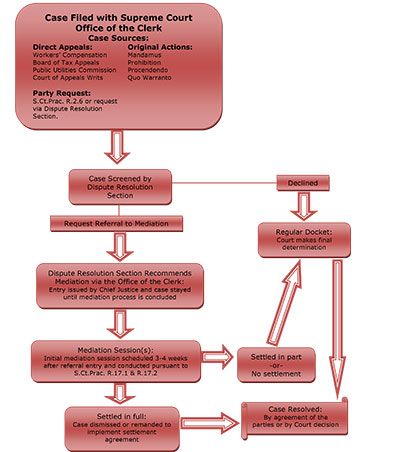Case Mediation Section FAQs
What is Mediation at the Supreme Court of Ohio?
What is the Supreme Court of Ohio's Mediation Process?
What are the Stages of Mediation at the Supreme Court of Ohio?
How Does an Attorney Prepare for Mediation?
What are the Advantages to Mediation?
What is Mediation at the Supreme Court of Ohio?
Mediation is a voluntary, confidential process in which the Court's mediator leads the litigating parties through a process that seeks to resolve their case with a mutually acceptable solution.
What is the Supreme Court of Ohio's Mediation Process?
Click the image below for a more detailed view.
What are the Stages of Mediation at the Supreme Court of Ohio?
Note: The mediator may adapt this model to the type of case or the individuals involved.
Stage 1: Introduction: At this stage, the mediator presents the basic formalities, including expectations, process details, and ground rules.Stage 2: Problem Identification: The mediator asks each party to explain the situation from each party's perspective. This begins moving the parties from their legal positions and toward discovering their underlying interests.
Stage 3: Summarization: After each party relates his or her point of view, the mediator summarizes what each person has said to ensure that the mediator and the other litigants have heard the party accurately.
Stage 4: Issue Identification: The mediator identifies the issues that are on the table and submits them to the parties for discussion.
Stage 5: Generating and Evaluating Options and Alternatives: The parties propose ideas with the intent to satisfy the interests of everyone involved. The mediator then facilitates negotiations on these ideas by encouraging the parties to assess the strengths and weaknesses of their proposals. Evaluation of these proposals sometimes leads to private discussions between the mediator and each party, called a "caucus." These negotiations frequently lead to a mutually acceptable solution. The mediator will confirm the agreement and obtain a commitment that the parties will undertake the actions necessary to conclude the case.
Stage 6: Legal/Review and Processing: All the parties will then review, revise, and execute the settlement agreement. This usually occurs after the conference has concluded. The parties circulate proposed settlement documents to confirm the agreement. The mediator monitors this phase to assure progress toward conclusion.
Stage 7: Implementation and Case Dismissal: Finally, after the parties have executed the settlement agreement, the parties will apply to dismiss the case or remand it to a lower forum to implement the agreement. The Court will dismiss or remand the case according to the document filed with the Court.
How Does an Attorney Prepare for Mediation?
- Identify the individuals who must be present.
- Set aside sufficient time for the mediation.
- Learn the process, including the stages of mediation.
- Educate client on aspects of mediation and possibilities for settlement; prepare client to speak for him or herself.
- Analyze settlement needs and send demand letter to opposing party if directed or otherwise helpful.
- Bring any important documents or data to the mediation to support your views.
- Disregard your legal arguments for the moment and focus on your best interests.
- Speak candidly about interests. The more candid and honest the parties are the better progress they make in resolving their differences.
- Review the strengths and weakness of seeking the Court's decision realistically, including the risks, costs, and time.
- Determine a range of acceptable outcomes.
- Emphasize the parties' roles as decision makers.
What are the Advantages to Mediation?
- Parties have increased control over the process and the outcome.
- Personal involvement of parties: Through direct contact with other parties, individuals are able to hear and understand the other side's point of view.
- Confidentiality
- Less adversarial and hostile process
- May decrease litigation time, thus saving the parties additional expense
- Creative resolutions
- Allows the parties to assess the strengths and weaknesses of both sides of the case
- Agreements conclude the dispute at the Supreme Court of Ohio, as well as in other legal forums
Acrobat Reader is a trademark of Adobe Systems Incorporated.

